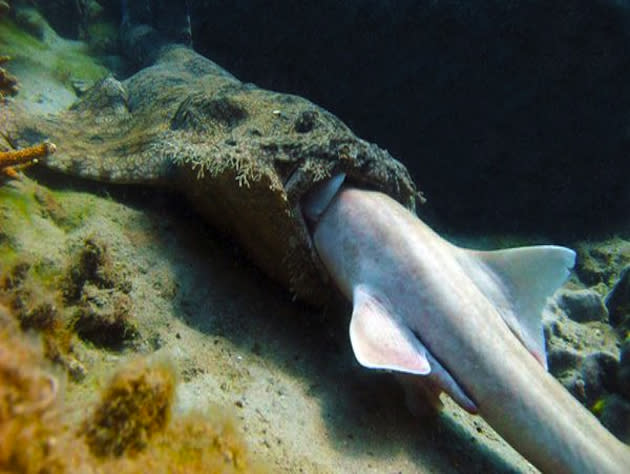 The Sideshow
The SideshowShark devours another shark whole (Photo)

National Geographic has released this soon-to-be classic photograph of one shark eating another shark whole.
The photo comes from Daniela Ceccarelli, of Australia's Research Council Center of Excellence for Coral Reef Studies. Ceccarelli was working with fellow researcher David Williamson on conducting a "fish census" off Great Keppel Island, part of the country's Great Barrier Reef. That's when Ceccarelli thought she spotted a brown-banded bamboo shark hanging out near the ocean's floor.
"The first thing that caught my eye was the almost translucent white of the bamboo shark," Ceccarelli told National Geographic in an email. Instead, as Ceccarelli moved in for a closer look she noticed a camouflaged wobbegong shark emerging from seclusion with the same bamboo shark partially wedged inside its jaws.
"It became clear that the head of the bamboo shark was hidden in its mouth," she said. "The bamboo shark was motionless and definitely dead."
As the New Scientist explains, Wobbegongs, aka carpet sharks, are silent predators, waiting at the bottom of the ocean floor for their pray to pass by. And as stunning as this photo may be, it's not uncommon for Wobbegongs to devour such large meals. Like several kinds of snakes, the Wobbegong has a dislocating jaw and rearward-pointing teeth that help it consume disproportionately large prey.
Although Wobbegongs bite humans with some regularity, these usually aren't actual attacks where the shark is hunting for prey. Rather, these bites tend to be more of a defensive reflex after the shark itself has been assaulted, usually by someone unintentionally stepping on it.
While shark attacks were down in the U.S. last year, deaths from shark bites more than doubled worldwide with 12 reported deaths all happening outside of the U.S. However, Florida still led the overall national count for most attacks, with 11 of the 29 attacks reported inside the U.S.
"We had a number of fatalities in essentially out-of-the-way places, where there's not the same quantity and quality of medical attention readily available," George Burgess, director of the Shark Attack File, told Gannett. "They also don't have histories of shark attacks in these regions, so there are not contingency plans in effect like there are in places such as Florida."
You can keep track of individual shark attack statistics here.
Other popular Yahoo! News stories:
• Diving Dogs: Underwater dog photography reveals news animal perspectives (Photos)
• "5-Hour Energy" drink inventor revealed to be a Buddhist monk billionaire


